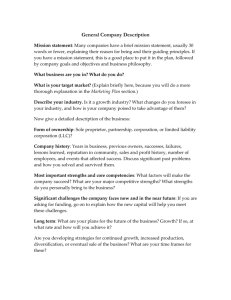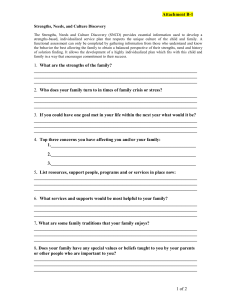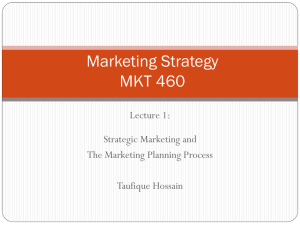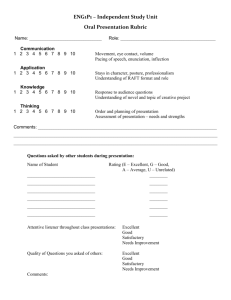Organization Fuhr
advertisement
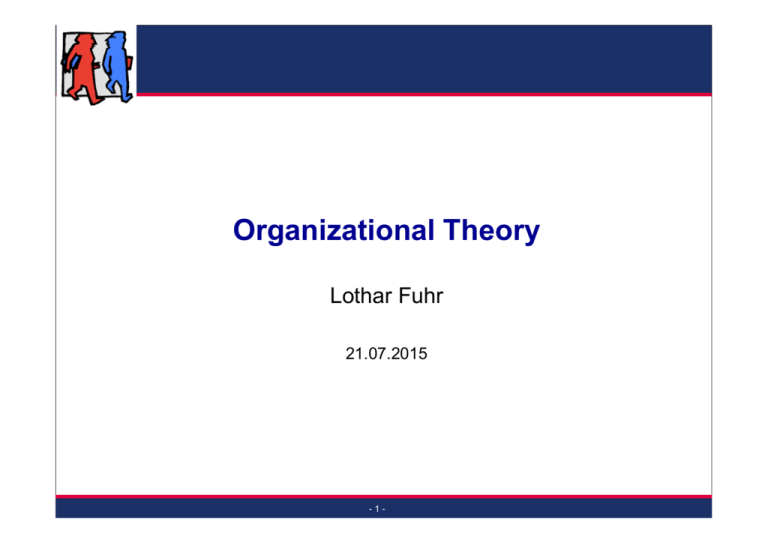
Organizational Theory Lothar Fuhr 21.07.2015 -1- Organizational Theory in 4 steps Learning Experience Clear Terms & Background History Outlook -2- ... Lothar.Fuhr@web.de -3- What is „Organization Theory“? What are „Organizations“? -4- What Is Organization Theory? A proposition or set of propositions that attempts to explain or predict how groups and individuals behave in differing organizational arrangements. Organization theory is characterized by vogues, heterogeneity, claims and counterclaims, and even greater differentiation in theory and practice have developed since then. -5- What Is Organization Theory? Classic organizational theory: Organizations exist to accomplish productionrelated and economic goals. There is one best way to organize for production, and that way can be found through systematic, scientific inquiry. Production is maximized through specialization and division of labor. People and organizations act in accordance with rational economic principles. -6- Share your experience ... -7- Road Map of Organizational Theory Behavior Approach Fundamentals of Organisational Theory Classic approach of Organisational Theory Psycho-Technic Behaviorismus „Modern“ approach of Organisational Theory „Institiutionalistisch“ Human Relations Neoclassical Perspective Economical Systemic Approach Situative Approach ... Bureaucratical Approach Scientific Management Ressource Based Approach Theory of Evolution Administrational Approach 1900 1920 1940 -8- Time History of Organizational Theory Scientific Management Representative: F. Taylor Key Question: How could we optimize our performance by using our ressources in a best way! (maximise output with the least amount of input) Focus: Divide work between managers and workers Provide incentive system (based on performance) Create a science for each individual‘s resp. Make sure work is done on time/efficiently -9- History of Organizational Theory Bureaucracy Approach Representative: M. Weber Key Question: Focus: How do we realise authority within an organisation Definition of „ideals“ (great man theory) Rules are stable and can be learned The management of the modern office is based upon written rule, which are preserved in original form Office of hierarchy - 10 - History of Organizational Theory Administrative Approach Representative: H. Fayol; Mary Parker Follet Key Question: How could we optimize our performance by using our ressources in a best way! Focus: Administration & Management - 11 - History of Organizational Theory Systemic Approach Representative: L. v Bertalanffy; C. Barnard; N. Luhmann; F. Malik Key Question: How do the elements of an organization interact Focus: elements, relations, ... - 12 - History of Organizational Theory Theory of Evolution Representative: H.E. Aldrich; McKelvey; M.T. Hannan, J. Freeman Key Question: Transfer from biological findings to the organisational perspective Focus: fact oriented management is not possible - 13 - A simple question ... 12 / 68 / 20 - 14 - - 15 - Why do we have all the problems? - 16 - Peter‘s Principle ... a typical problem! - 17 - Why do we have all the problems? „Mistakes are the result of habit!“ - 18 - An additional perspective … Don Beck: Spyral Dynamics - 19 - ©Institut Innere Form Why Have a Structure? . . . All businesses have to organise what they do! A clear structure makes it easier to see which part of the business does what! There are many ways to structure a business! - 20 - Some Key Terms Flat or tall structure Span of control Chain of command Hierarchy Delegation Empowerment - 21 - Ways to Structure a Business . . . By function: arranging the business according to what each section or department does By product or activity: organising according to the different products made By area: geographical or regional structure - 22 - Ways to Structure a Business By customer: where different customer groups have different needs . By process: where products have to go through stages as they are made . . What are the advantages/disadvantages of different types of business structure? - 23 - Functional Structure Advantages . . . Disadvantages Specialisation – each department focuses on its own work Accountability – someone is responsible for the section Clarity – know your and others’ roles . . . . - 24 - Closed communication could lead to lack of focus Departments can become resistant to change Coordination may take too long Gap between top and bottom Organisation by Product/Activity Advantages . . . Disadvantages Clear focus on market segment helps meet customers’ needs Positive competition between divisions Better control as each division can act as separate profit centre . . . - 25 - Duplication of functions (e.g. different sales force for each division) Negative effects of competition Lack of central control over each separate division Organisation by Area Disadvantages Advantages . . . Serve local needs better Positive competition More effective communication between firm and local customers - 26 - . . Conflict between local and central management Duplication of resources and functions Other Organisational Structures . . By Customer: Similar effects to structuring by product By Process: Similar to structuring by function - 27 - - 28 - Holistic view – made by St. Gallen (CH) Communication 5 Tasks for Effective Management Communication 6 Principles for Effective Management Communication Tools for Effective Management Communication - 29 - 7 Effective Management 6 Principles for Effective Management 1. Result-Orientation 2. Contributing to the Whole 3. Concentrating on the Essentials 4. Utilizing Strengths 5. Trust 6. Positive Thinking - 30 - Results-Orientation The focus should not be on working as hard as possible, but on achieving the best possible results. Within their position, employees should be capable of attaining results and also have an opportunity to see these results. This contributes significantly to motivation. Management is concerned with effectuation or achieving results. Result orientation is a management principle and should not be taken as a general life principle. Results can only be evaluated in terms of the organizational goal. Results can be related to individuals or to money. The work itself doesn‘t bring happiness, but rather the results. ... - 31 - Contributing to the Whole Good managers make it easier for their employees to perceive their contribution to the whole and to recognize the purpose of their job. A good manager sees the big picture and views his purpose in contributing to the whole, regardless of position or area of spezialisation. Holistic thinking means always meintaining an overview of the complete organizational organism. The goal is translation potential into benefit. Contributions to the whole are based on the efficient use of knowledge, skills and experience to benefit company performance. ... - 32 - Concentration on the Essentials Management should ensure that individuals within a company concentrate on a small number of carefully choosen items, so as not to dissipate their energies. Concentration is the key to positive results. Concentration is the key to results. It is important to concentrate on a small number of items; however, these should be the most important ones. Success is enabled by carefully selecting a specific focus and concentrating on it. The world is not short on ideas, but is short on realized ideas, which again require concentration. ... - 33 - Positive Thinking Recognizing and utilizing opportunities is considerably more important than simply overcoming issues. When issues areise, people should look at the potentially positive sides and determine if there are hidden opportunities within this issue. Positive thinking also includes the discipline of self motivation. Closely related to this is the principle that people always try to use everything at their disposal to make the best of a particular situation. Good managers think positively and constructively. It is important not to cocentrate on the problems within the oragnization, but rather on the opportunities. Positive thinking leads to the utilization of opportunities and to self motivation. ... - 34 - Utilizing Strengths Individuals should be engaged in the tasks they are suited for and where their strengths lie. Human resource development should be based on strengths. Weaknesses should only be minimized to the degree that they impede upon the complete utilization of strengths. It is important to make use of already existing strengths and not to concentrate on weaknesses. It is a managers job to recognize the strengths of his/her employees and then align tasks with the strengths of the respective individuals. Overcoming weaknesses frequently leads quickly to physical or mental exhaustion. ... - 35 - Trust To create a good corporate culture and good working climate, it is key to gain the trust of employees. This creates a stable management situation that holds up solidly in the face of the management mistakes that will inevitably occur. Try to put as much trust as you can into individuals; extend it to the limits. Ensure that it is clear what happens if there is a breach of trust, what the penalties are for such actions and react firmly. Fundamental to the principle of trust is that the trust must be real. Feigned trust has a counterproductive effect. ... - 36 - Effective Management 5 Tasks for Effective Management 1. Setting Goals 2. Organization 3. Making Decisions 4. Controlling 5. Human Ressource Development - 37 - Effective Management 7 Tools for Effective Management 1. The Meeting 2. The Report 3. Job Design and Assignment Control 4. Personal Work Methods 5. Budget and Budgeting 6. Evaluating Performance 7. Systematic Waste Disposal - 38 - Back-Up - 39 - Models of Organizational Practice Include . . . . . . . . Theory X. Control, discipline, and sanctions are needed to force people to do their work. Theory Y. Management can take action so that employees will become motivated to do their work. All workers are to be regarded as goal-oriented and as having potential to further develop their own talents and skills. Contingency Theory – Employees are motivated by different things, but need to achieve a sense of competency. Therefore the manager must provide appropriate incentives to motivate individual employees. Human Relations Approach. To maximize performance, staff members need autonomy, involvement in management decisions, and appropriate rewards. People react as group members. Theory Z – focuses on quality of production, collective accountability and loyalty. Decisions are made by consensus. Participatory Management – Staff involvement in organizational decision-making increases job satisfaction and productivity; decreases staff turnover. Feminist Management - Fights oppression; creates “management partnerships” among participants; assumes women manage differently then men, focusing on interpersonal relationships rather than traditional approaches to power & authority. Decisions are made by consensus & cooperation. Total Quality Management – Management produces an organizational culture based on product quality, consumer satisfaction, standardization of production, and employee empowerment. - 40 - The Origins of Scientific Management The influence of Frederick W. Taylor (1911): Father of the scientific management movement. Scientific management principles. Replacing traditional, rule of thumb methods of work accomplishment with systematic, more scientific methods of measuring and managing individual work elements; The scientific study of the selection and sequential development of workers to ensure optimal placement of works into work roles; Obtaining the cooperation of workers to ensure full application of scientific principles; And. Establishing logical divisions within work roles and responsibilities between workers and management. - 41 - The Origins of Scientific Management Henri Fayol’s general theory of management (six principles, 1916, 1949). Technical (production of goods) Commercial (buying, selling, exchange). Financial (raising and using capital). Security (protection of property and people). Accounting. Managerial (coordination, control, organization, planning and command of people). - 42 - The Origins of Scientific Management Fayol (contd.). Dominant principle was management Division of work. Authority and responsibility. Discipline. Unity of command. Unity of direction. Subordination of individual interest to general interest. Remuneration of personnel. - 43 - The Origins of Scientific Management Fayol (contd.) Dominant principle was management (contd.) Centralization. Scalar chains (supervisors). Order. Equity. Stability of personnel tenure. Initiative, and. Esprit de corps. - 44 - Neoclassical Organization Theory . The neoclassical theorists gained their reputation by attacking the classical theories. Important source of the power and politics, organizational culture, and systems theory. . Herbert Simon. Bounded rationality and satisficing. Programmed and unprogrammed decisionmaking. Management information systems. - 45 - Systems Theory Systems theory views an organization as a complex set of dynamically intertwined and interconnected elements, including inputs, processes, outputs, feedback loops, and the environment. Any change in one element causes changes in other elements. - 46 - Systems Theory Cybernetics – Norbert Wiener (1948). - 47 - Systems Theory The learning organization. Built on the doctrines of participation Maslow’s hierarchy of needs. New component technologies (the five disciplines). Personal mastery. Mental models. Building shared vision. Team learning. Systems thinking. - 48 -

